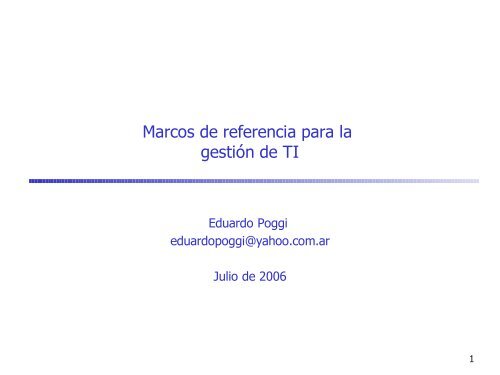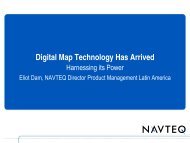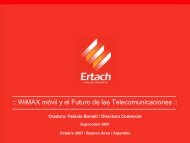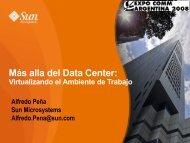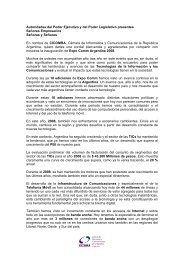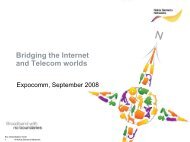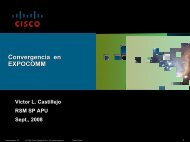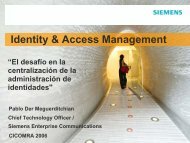Marcos de referencia para la gestión de TI - CICOMRA
Marcos de referencia para la gestión de TI - CICOMRA
Marcos de referencia para la gestión de TI - CICOMRA
Create successful ePaper yourself
Turn your PDF publications into a flip-book with our unique Google optimized e-Paper software.
<strong>Marcos</strong> <strong>de</strong> <strong>referencia</strong> <strong>para</strong> <strong>la</strong><br />
gestión <strong>de</strong> <strong>TI</strong><br />
Eduardo Poggi<br />
eduardopoggi@yahoo.com.ar<br />
Julio <strong>de</strong> 2006<br />
1
Objetivos <strong>de</strong> <strong>la</strong> presentación<br />
<br />
<br />
<br />
<br />
Enten<strong>de</strong>r el por qué <strong>de</strong> los <strong>Marcos</strong> <strong>de</strong> Referencia.<br />
Vislumbrar <strong>la</strong> diversidad <strong>de</strong> <strong>Marcos</strong> <strong>de</strong> Referencia <strong>para</strong> <strong>la</strong><br />
gestión <strong>de</strong> <strong>TI</strong> y <strong>la</strong> re<strong>la</strong>ción entre ellos.<br />
Conocer los principales marcos.<br />
Presentar algunas i<strong>de</strong>as y herramientas <strong>para</strong> analizar su<br />
utilidad <strong>para</strong> distintos tipos <strong>de</strong> organizaciones.<br />
2
Temario<br />
<br />
<br />
<br />
<br />
Estado <strong>de</strong> situación<br />
IT Governance<br />
CObIT<br />
I<strong>TI</strong>L<br />
ISO 17.799<br />
<br />
<br />
CMM<br />
Conclusiones<br />
3
Estado <strong>de</strong> situación<br />
4
Logos, diplomas y cocardas …<br />
5
The new datacenter<br />
"These frameworks<br />
(COBIT, I<strong>TI</strong>L, ISO17799<br />
and CMM) were written<br />
by different groups at<br />
different times for<br />
different reasons . . .<br />
but each has<br />
contributions to make to<br />
the new (virtualized)<br />
data center."<br />
David Pultorak,<br />
presi<strong>de</strong>nt of Fox IT<br />
Network World, 02/21/05<br />
6
Negocios y <strong>TI</strong><br />
“Tras analizar los datos sobre <strong>la</strong><br />
inversión en <strong>TI</strong> y el <strong>de</strong>sempeño<br />
financiero <strong>de</strong> 350 corporaciones <strong>de</strong><br />
Estados Unidos, <strong>de</strong>scubrieron que<br />
fueron los consumidores los que se<br />
quedaron con <strong>la</strong> mayor parte <strong>de</strong> los<br />
beneficios económicos <strong>de</strong>rivados <strong>de</strong>l<br />
aumento <strong>de</strong> <strong>la</strong> productividad. De<br />
hecho, los investigadores<br />
encontraron indicios <strong>de</strong> que <strong>la</strong>s<br />
inversiones en IT a veces tendieron<br />
a <strong>de</strong>bilitar <strong>la</strong> rentabilidad<br />
corporativa, y no a fortalecer<strong>la</strong>.”<br />
Nicho<strong>la</strong>s Carr<br />
2004<br />
7
¿Es importante <strong>la</strong> <strong>TI</strong><br />
“El gran peligro <strong>para</strong> los<br />
gerentes es seguir creyendo<br />
que tecnología en sí misma es<br />
estratégica, que <strong>la</strong>s<br />
innovaciones en IT pue<strong>de</strong>n dar<br />
significativas ventajas<br />
competitivas. Ese punto <strong>de</strong><br />
vista lleva a excesivas<br />
inversiones, a asumir riesgos<br />
innecesarios y luego, a <strong>la</strong><br />
<strong>de</strong>cepción.”<br />
Nicho<strong>la</strong>s Carr<br />
2004<br />
8
Estado <strong>de</strong> situación - ¿Por qué<br />
<br />
<br />
Muchos casos <strong>de</strong> gran<strong>de</strong>s inversiones en <strong>TI</strong> pero:<br />
<br />
<br />
<br />
Información poco útil y dudosa.<br />
Inversiones no alineadas –e incluso contraproducentes- a los<br />
intereses <strong>de</strong>l negocio.<br />
Fugas <strong>de</strong> información sensible.<br />
Creciente interre<strong>la</strong>ción <strong>TI</strong>-Negocio<br />
9
Estado <strong>de</strong> situación - ¿Por qué<br />
<br />
El problema <strong>de</strong> <strong>la</strong> <strong>TI</strong>:<br />
<br />
<br />
<br />
<br />
¿Está haciendo <strong>la</strong>s cosas correctas<br />
¿Las está haciendo correctamente<br />
¿Las que están hechas, están bien hechas<br />
¿Estamos recibiendo los beneficios<br />
10
Evolución <strong>de</strong> los MR <strong>para</strong> <strong>la</strong> gestión <strong>de</strong> <strong>TI</strong><br />
11
Estado <strong>de</strong> situación – <strong>Marcos</strong> <strong>de</strong><br />
Referencia<br />
<br />
<br />
<br />
<br />
<br />
<br />
<br />
Verticales: SOX, Basilea II.<br />
Management: COSO (USA), CoCo (Canadá), Cadbury<br />
(Uk), GAAP.<br />
Gestión <strong>de</strong> <strong>TI</strong>: CObIT, SISA<br />
Seguridad: BS7799, ISO17799, ISO27001/2<br />
D&S: BS15000, SPICE, I<strong>TI</strong>L, MOF<br />
Indicadores: BSC, ISO9000, SixSigma<br />
Software: TickIT, CMM-I, CMM-SW<br />
Calidad: ISO 9000<br />
<br />
Otros: TCO, PMI, …<br />
12
Estado <strong>de</strong> Situación – Ejemplos <strong>de</strong> MR <strong>para</strong><br />
<strong>la</strong> calidad <strong>de</strong>l software<br />
13
<strong>Marcos</strong> <strong>de</strong> Referencia - Objetivos<br />
<br />
Con un alcance amplio o específico, todos los marcos<br />
preten<strong>de</strong>n lograr el “Gobierno <strong>de</strong> <strong>TI</strong>”:<br />
<br />
<br />
<br />
<br />
<br />
Dirigir: Alinear <strong>la</strong> gestión <strong>de</strong> <strong>TI</strong> al negocio<br />
Crear: Asegurar <strong>la</strong> creación <strong>de</strong> valor<br />
Proteger: Administrar los riesgos<br />
Actuar: Administrar el uso <strong>de</strong> los recursos<br />
Monitorear: Administrar el <strong>de</strong>sempeño<br />
14
Estado <strong>de</strong> situación - Hechos<br />
<br />
<br />
<br />
<br />
<br />
<br />
<br />
<br />
<br />
Existe una diversidad <strong>de</strong> <strong>Marcos</strong> <strong>de</strong> Referencia y <strong>de</strong> certificaciones<br />
re<strong>la</strong>cionadas a <strong>la</strong> Gestión <strong>de</strong> <strong>TI</strong>.<br />
La diversidad, <strong>la</strong> falta <strong>de</strong> información y <strong>la</strong> propia industria aportan a<br />
<strong>la</strong> confusión sobre su real utilidad.<br />
Existen marcos generales y marcos específicos.<br />
Los diferentes marcos se superponen en muchos aspectos pero se<br />
complementan en otros.<br />
No hay buenos “mappings” entre los distintos marcos <strong>para</strong> analizar<br />
<strong>la</strong> re<strong>la</strong>ción entre ellos.<br />
Es uno <strong>de</strong> los productos estrel<strong>la</strong> <strong>de</strong> <strong>la</strong> industria <strong>de</strong> <strong>TI</strong> y <strong>la</strong> consultoría<br />
re<strong>la</strong>cioanda.<br />
Hay una <strong>de</strong>manda creciente <strong>de</strong>l mercado <strong>para</strong> su adopción.<br />
Hay casos <strong>de</strong> adopción exitosos.<br />
Hay casos <strong>de</strong> adopción muy costosos.<br />
15
<strong>Marcos</strong> <strong>de</strong> Referencia - Expectativas<br />
<br />
<br />
<br />
<br />
<br />
Promover <strong>la</strong> visión <strong>de</strong> <strong>TI</strong> como proveedor <strong>de</strong> servicios<br />
Fomentar el foco en el cliente<br />
Posicionar <strong>TI</strong> en <strong>la</strong> ca<strong>de</strong>na <strong>de</strong> valor<br />
Estandarizar procesos<br />
Mejorar <strong>la</strong> comunicación Negocio-<strong>TI</strong> gracias a un<br />
lenguaje comun<br />
16
<strong>Marcos</strong> <strong>de</strong> Referencia - Expectativas<br />
<br />
Lograr una gestión <strong>de</strong> <strong>TI</strong> Pre<strong>de</strong>cible:<br />
<br />
<br />
<br />
<br />
<br />
Mejor calidad, funcionalidad y facilidad <strong>de</strong> uso<br />
Entrega más rápida <strong>de</strong> información<br />
Mejora <strong>de</strong> los niveles <strong>de</strong> servicio<br />
Disminución <strong>de</strong> los costos<br />
Garantías <strong>de</strong> continuidad<br />
17
¿Por qué <strong>la</strong>s empresas los adoptan<br />
18<br />
Forrester Research Inc, n=678
COBIT<br />
Control OBjetives por<br />
Information and<br />
re<strong>la</strong>ted Technologies<br />
19
COBIT – Historia<br />
<br />
<br />
<br />
<br />
<br />
<br />
<br />
Creado por Information Systems Audit and Control<br />
Association con <strong>la</strong> participación <strong>de</strong>l IT Governance<br />
Institute.<br />
Abarca más <strong>de</strong> 150 capítulos en 50 países.<br />
En 1992 comenzó <strong>la</strong> actualización <strong>de</strong> los objetivos <strong>de</strong><br />
control <strong>de</strong> ISACA.<br />
En 1996 presentó el primer marco <strong>de</strong> <strong>referencia</strong> <strong>para</strong><br />
<strong>la</strong> gestión <strong>de</strong> <strong>TI</strong>.<br />
En 2000 se presentó <strong>la</strong> 3ra edición <strong>de</strong> los manuales.<br />
En diciembre <strong>de</strong> 2005 se presentaron los principales<br />
manuales <strong>de</strong> <strong>la</strong> 4ta versión.<br />
Es el estándar <strong>de</strong> los organismos <strong>de</strong> control<br />
gubernamentales.<br />
20
COBIT – Misión y Visión<br />
<br />
<br />
Misión: Investigar, <strong>de</strong>sarrol<strong>la</strong>r, publicar y promover un<br />
conjunto <strong>de</strong> objetivos <strong>de</strong> control <strong>de</strong> <strong>TI</strong> rectores,<br />
actualizados, internacionales y generalmente aceptados<br />
<strong>para</strong> ser utilizados en <strong>la</strong> gestión cotidiana <strong>de</strong> <strong>TI</strong>.<br />
Visión: Consolidarse como un lí<strong>de</strong>r mundialmente<br />
reconocido en materia <strong>de</strong> gobierno, control y<br />
aseguramiento <strong>de</strong> <strong>la</strong> gestión <strong>de</strong> <strong>TI</strong>.<br />
21
COBIT - Productos<br />
<br />
<br />
<br />
<br />
<br />
<br />
<br />
Sumario Ejecutivo:<br />
<br />
Marco:<br />
<br />
“Es un mo<strong>de</strong>lo…”<br />
“El mo<strong>de</strong>lo es…”<br />
Objetivos <strong>de</strong> control:<br />
“Los controles mínimos son…”<br />
Pautas <strong>de</strong> Gestión:<br />
“Cómo se pue<strong>de</strong> medir el <strong>de</strong>sempeño…”<br />
Pautas <strong>de</strong> Auditoría:<br />
<br />
“Cómo se pue<strong>de</strong> auditar…”<br />
Implementación:<br />
<br />
“Cómo se pue<strong>de</strong> implementar…”<br />
QuickCOBIT:<br />
<br />
“Cómo empezar…”<br />
22
COBIT – Principios y conceptos<br />
R<br />
E<br />
C<br />
U<br />
R<br />
S<br />
O<br />
S<br />
P<strong>la</strong>nificación y Organización<br />
Adquisición e Imp<strong>la</strong>ntación<br />
Entrega y Soporte,<br />
Monitoreo<br />
Procesos <strong>de</strong><br />
<strong>TI</strong><br />
Datos<br />
Aplicaciones<br />
Tecnología<br />
Insta<strong>la</strong>ciones<br />
Personal<br />
I<br />
N<br />
F<br />
O<br />
R<br />
M<br />
A<br />
C<br />
I<br />
O<br />
N<br />
Lo que se<br />
necesita<br />
Eficacia<br />
Eficiencia<br />
Confi<strong>de</strong>ncialidad<br />
Integridad<br />
Disponibilidad<br />
Cumplimiento<br />
Confiabilidad<br />
Lo que se<br />
obtiene<br />
N<br />
E<br />
G<br />
O<br />
C<br />
I<br />
O<br />
23<br />
Vincu<strong>la</strong>r <strong>la</strong>s expectativas <strong>de</strong> <strong>la</strong> Dirección con <strong>la</strong>s responsabilida<strong>de</strong>s<br />
Gerenciales <strong>de</strong> <strong>TI</strong>
Marco <strong>de</strong> <strong>referencia</strong><br />
Requerimientos <strong>de</strong> negocio<br />
Criterios <strong>de</strong> información<br />
Monitoreo<br />
Recursos<br />
P<strong>la</strong>nificación y<br />
Organización<br />
Entrega y<br />
soporte<br />
Adquisición e<br />
implementación<br />
24
COBIT - Procesos<br />
<br />
(4) Dominios: agrupan <strong>la</strong> responsabilidad <strong>de</strong>ntro <strong>de</strong> una<br />
estructura encuadrada en el ciclo <strong>de</strong> vida <strong>de</strong> los procesos<br />
<strong>de</strong> <strong>TI</strong>.<br />
<br />
<br />
<br />
<br />
<br />
<br />
(34) Procesos: Serie <strong>de</strong> activida<strong>de</strong>s vincu<strong>la</strong>das con cortes <strong>de</strong> control<br />
naturales.<br />
<br />
(318) Activida<strong>de</strong>s y Tareas: necesarias <strong>para</strong> lograr un resultado<br />
mensurable. Las activida<strong>de</strong>s tienen un ciclo <strong>de</strong> vida mientras que<br />
<strong>la</strong>s tareas sin discretas.<br />
Nivel <strong>de</strong> Madurez<br />
Factores Críticos <strong>de</strong> Éxito<br />
Indicadores <strong>de</strong> C<strong>la</strong>ve <strong>de</strong> Desempeño<br />
Indicadores C<strong>la</strong>ve <strong>de</strong> Meta<br />
Guía <strong>para</strong> auditoría<br />
25
COBIT – Dominios y Objetivos<br />
P<strong>la</strong>nificación y Organización<br />
Entrega y Servicio<br />
<br />
<br />
<br />
<br />
<br />
<br />
<br />
<br />
<br />
<br />
<br />
PO1-Definición <strong>de</strong> un p<strong>la</strong>n estratégico.<br />
PO2-Definición <strong>de</strong> <strong>la</strong> arquitectura <strong>de</strong> <strong>la</strong><br />
información.<br />
PO3-Determinación <strong>de</strong> <strong>la</strong> dirección tecnológica.<br />
PO4-Definición <strong>de</strong> <strong>la</strong> organización y <strong>la</strong>s<br />
re<strong>la</strong>ciones <strong>de</strong> <strong>TI</strong>.<br />
PO5-Administración <strong>de</strong> <strong>la</strong> inversión en <strong>TI</strong>.<br />
PO6-Comunicación <strong>de</strong> los objetivos y directivas<br />
<strong>de</strong> <strong>la</strong> gerencia.<br />
PO7-Administración <strong>de</strong> los recursos humanos.<br />
PO8-Garantía <strong>de</strong> cumplimiento <strong>de</strong> los<br />
requerimientos externos.<br />
PO9-Evaluación <strong>de</strong> riesgos.<br />
PO10-Administración <strong>de</strong> proyectos.<br />
PO11-Administración <strong>de</strong> <strong>la</strong> calidad.<br />
Adquisición e Imp<strong>la</strong>ntación<br />
<br />
<br />
<br />
<br />
<br />
<br />
<br />
<br />
<br />
<br />
<br />
<br />
<br />
ES1-Definición <strong>de</strong> Niveles <strong>de</strong> Servicio<br />
ES2-Administración <strong>de</strong> Servicios prestados por<br />
Terceros<br />
ES3-Administración <strong>de</strong> Desempeño y Capacidad<br />
ES4-Aseguramiento <strong>de</strong> Servicio Continuo<br />
ES5-Garantizar <strong>la</strong> Seguridad <strong>de</strong> Sistemas<br />
ES6-I<strong>de</strong>ntificación y Asignación <strong>de</strong> Costos<br />
ES7-Educación y Entrenamiento <strong>de</strong> Usuarios<br />
ES8-Apoyo y Asistencia a los Clientes <strong>de</strong><br />
Tecnología <strong>de</strong> Información<br />
ES9-Administración <strong>de</strong> <strong>la</strong> configuración<br />
ES10-Administración <strong>de</strong> Problemas e Inci<strong>de</strong>ntes<br />
ES11-Administración <strong>de</strong> Datos<br />
ES12-Administración <strong>de</strong> Insta<strong>la</strong>ciones<br />
ES13-Administración <strong>de</strong> Operaciones<br />
26<br />
<br />
<br />
<br />
<br />
<br />
<br />
AI1-I<strong>de</strong>ntificación <strong>de</strong> soluciones automatizadas.<br />
AI2-Adquisición y mantenimiento <strong>de</strong>l software<br />
<strong>de</strong> aplicación.<br />
AI3-Adquisición y mantenimiento <strong>de</strong> <strong>la</strong><br />
infraestructura tecnológica.<br />
AI4-Desarrollo y mantenimiento <strong>de</strong><br />
procedimientos <strong>de</strong> <strong>TI</strong>.<br />
AI5-Insta<strong>la</strong>ción y acreditación <strong>de</strong> sistemas.<br />
AI6-Administración <strong>de</strong> cambios.<br />
<br />
<br />
<br />
<br />
Monitoreo<br />
MO1-Monitoreo <strong>de</strong>l Proceso<br />
MO2-Evaluar lo a<strong>de</strong>cuado <strong>de</strong>l Control Interno<br />
MO3-Obtención <strong>de</strong> Aseguramiento<br />
In<strong>de</strong>pendiente<br />
MO4-Proveer Auditoria In<strong>de</strong>pendiente
COBIT – Ejemplo:<br />
PO2 - Arquitectura <strong>de</strong> <strong>la</strong> información<br />
<br />
<br />
<br />
<br />
Requerimiento <strong>de</strong> negocio:<br />
<br />
Organizar los SI <strong>de</strong> <strong>la</strong> manera más a<strong>de</strong>cuada.<br />
Realizarse por medio <strong>de</strong>:<br />
<br />
Creando y manteniendo un mo<strong>de</strong>lo <strong>de</strong> información <strong>de</strong> negocio y<br />
<strong>la</strong> <strong>de</strong>finición <strong>de</strong> los sistemas a<strong>de</strong>cuados a fin <strong>de</strong> optimizar el uso<br />
<strong>de</strong> <strong>la</strong> información.<br />
Utilizando como recursos:<br />
<br />
Aplicaciones y Datos<br />
Afectando a los criterios <strong>de</strong> información:<br />
<br />
<br />
Efectividad<br />
Eficiencia, Confi<strong>de</strong>ncialidad e Integridad<br />
27
COBIT – Ejemplo:<br />
PO2 - Arquitectura <strong>de</strong> <strong>la</strong> información<br />
<br />
Objetivos <strong>de</strong> control:<br />
<br />
<br />
<br />
<br />
Mo<strong>de</strong>lo <strong>de</strong> arquitectura <strong>de</strong> <strong>la</strong> información:<br />
<br />
“… crear y mantener actualizado un mo<strong>de</strong>lo <strong>de</strong> arquitectura <strong>de</strong> <strong>la</strong><br />
información que incluya el mo<strong>de</strong>lo <strong>de</strong> datos corporativo y <strong>la</strong> re<strong>la</strong>ción<br />
con los sistemas <strong>de</strong> información…”<br />
Diccionario <strong>de</strong> datos corporativos y reg<strong>la</strong>s <strong>de</strong> sintaxis <strong>de</strong> los<br />
datos.<br />
Esquema <strong>de</strong> c<strong>la</strong>sificación <strong>de</strong> datos.<br />
Niveles <strong>de</strong> seguridad.<br />
28
COBIT – Ejemplo:<br />
PO2 - Arquitectura <strong>de</strong> <strong>la</strong> información<br />
<br />
<br />
<br />
Consi<strong>de</strong>rar los Factores Críticos <strong>de</strong> Éxito:<br />
<br />
<br />
Los estándares <strong>de</strong> <strong>la</strong> arquitectura <strong>de</strong> <strong>la</strong> información se<br />
documentan, se comunican y se cumplen.<br />
La responsabilidad sobre los datos está asignada y aceptada<br />
Se mi<strong>de</strong> con los Indicadores <strong>de</strong> C<strong>la</strong>ve <strong>de</strong> Desempeño:<br />
<br />
<br />
Cantidad <strong>de</strong> cambios en <strong>la</strong>s aplicaciones realizados <strong>para</strong> realinear<br />
el mo<strong>de</strong>lo <strong>de</strong> datos<br />
Cantidad <strong>de</strong> inci<strong>de</strong>ntes <strong>de</strong> aplicaciones y sistemas causados por<br />
incoherencias en el mo<strong>de</strong>lo <strong>de</strong> datos.<br />
Se mi<strong>de</strong> contra los Indicadores C<strong>la</strong>ve <strong>de</strong> Meta:<br />
<br />
<br />
<br />
Desarrollo más rápido <strong>de</strong> <strong>la</strong>s aplicaciones<br />
Reducción <strong>de</strong> <strong>la</strong> redundancia <strong>de</strong> datos<br />
Mayor interoperabilidad entre sistemas y aplicaciones<br />
29
COBIT – Madurez <strong>de</strong> los procesos<br />
Mejorado<br />
Fuera <strong>de</strong> control<br />
Estandarizado y<br />
consistente<br />
Bajo control<br />
Previsible<br />
Mejora continua<br />
3-Definido<br />
4-Manejado<br />
5-Optimizado<br />
Monitoreo <strong>de</strong>l<br />
proceso<br />
Automatización <strong>de</strong><br />
<strong>la</strong>s mejores prácticas<br />
Disciplinado<br />
1-Inicial<br />
2-Repetible<br />
Administración <strong>de</strong>l<br />
proceso<br />
Formalización <strong>de</strong>l<br />
proceso<br />
30
COBIT – Madurez <strong>de</strong> los procesos<br />
5-Optimizado<br />
1-Inicial<br />
2-Repetible<br />
3-Definido<br />
4-Administrado<br />
0-Inexistente<br />
- Estado actual <strong>de</strong> <strong>la</strong><br />
empresa<br />
- Estándares internacionales<br />
- Prácticas <strong>de</strong> <strong>la</strong> industria<br />
Brecha<br />
Nivel<br />
mínimo<br />
razonablemente<br />
a<strong>de</strong>cuado.<br />
- Estrategia corporativa<br />
31
COBIT – Brecha<br />
ES10<br />
ES5<br />
ES4<br />
M1<br />
6 PO1 PO2<br />
4<br />
2<br />
0<br />
PO3<br />
PO7<br />
PO9<br />
ES1<br />
AI5<br />
AI2<br />
AI1<br />
Real<br />
Deseable<br />
32
COBIT – Conclusiones<br />
<br />
<br />
<br />
<br />
<br />
<br />
<br />
Cubre todos los procesos <strong>de</strong> <strong>TI</strong>.<br />
Orientado a: ¿Qué hacer<br />
Define un nivel <strong>de</strong> madurez estandarizado <strong>para</strong> todos los<br />
procesos.<br />
Exige procedimientos, responsables y registros.<br />
Define controles.<br />
Define métricas e indicadores.<br />
Determina una herramienta y un lenguaje común <strong>para</strong><br />
<strong>la</strong>s áreas <strong>de</strong> negocio, <strong>TI</strong> y <strong>de</strong> control.<br />
33
I<strong>TI</strong>L<br />
Information<br />
Technologies<br />
Infraestructure<br />
Library<br />
34
I<strong>TI</strong>L - Origen<br />
<br />
<br />
<br />
En 1987, <strong>la</strong> OGC (Office of Government Commerce) <strong>de</strong>l<br />
gobierno británico, inició un proyecto l<strong>la</strong>mado GI<strong>TI</strong>MM<br />
(Government IT Infrastructure Management Method).<br />
Comisionó a varias firmas <strong>de</strong> consultoría <strong>para</strong> investigar<br />
y documentar <strong>la</strong>s mejores prácticas <strong>de</strong> p<strong>la</strong>nificación y<br />
operación <strong>de</strong> <strong>la</strong> infraestructura <strong>de</strong> IT.<br />
El sector privado se interesó rápidamente y antes <strong>de</strong> <strong>la</strong><br />
primera publicación <strong>de</strong>l libro “Help Desk”, GI<strong>TI</strong>MM se<br />
transformó en I<strong>TI</strong>L.<br />
35
I<strong>TI</strong>L - ¿Qué es<br />
<br />
<br />
<br />
<br />
<br />
<br />
<br />
<br />
<br />
Una seria <strong>de</strong> libros con <strong>la</strong>s mejores prácticas <strong>de</strong> IT.<br />
Marco <strong>de</strong> <strong>referencia</strong> <strong>de</strong> dominio público.<br />
Probado empíricamente.<br />
Está bajo constante <strong>de</strong>sarrollo.<br />
Es soportado por herramientas.<br />
Es el estándar <strong>de</strong> facto mundial <strong>para</strong> Administración <strong>de</strong> Servicios <strong>de</strong><br />
IT.<br />
Utilizado por <strong>la</strong> mayoría <strong>de</strong> los gran<strong>de</strong>s data-centers <strong>de</strong> mundo.<br />
“I<strong>TI</strong>L Comp<strong>la</strong>int” en un slogan utilizado por el software específico.<br />
Tiene su propio grupo <strong>de</strong> usuarios internacional (IT Service<br />
Management Forum).<br />
Funcional a <strong>la</strong> certificación ISO 9000.<br />
Base <strong>para</strong> <strong>la</strong> certificación ISO/IEC 20000.<br />
36
I<strong>TI</strong>L - Libros<br />
37
The “big picture” of I<strong>TI</strong>L Processes<br />
38
I<strong>TI</strong>L - Libros<br />
39<br />
<br />
<br />
<br />
<br />
<br />
<br />
<br />
I<strong>TI</strong>L Service Delivery<br />
I<strong>TI</strong>L Service Support<br />
I<strong>TI</strong>L ICT Infrastructure<br />
Management<br />
I<strong>TI</strong>L P<strong>la</strong>nning to<br />
Implement Service<br />
management<br />
I<strong>TI</strong>L Software Asset<br />
Management<br />
I<strong>TI</strong>L Security Management<br />
I<strong>TI</strong>L Applications<br />
Management
Security Management<br />
<br />
<br />
Incorpora los conceptos y consi<strong>de</strong>raciones <strong>de</strong> seguridad<br />
<strong>de</strong>ntro <strong>de</strong> cada proceso y en cada aspecto <strong>de</strong> <strong>la</strong><br />
administración <strong>de</strong> los servicios en los niveles: operativo,<br />
táctico y estratégico<br />
Tienen en cuenta <strong>la</strong> estrategia <strong>de</strong> seguridad y los<br />
requerimientos que forman parte <strong>de</strong> los SLA.<br />
40
Application Management<br />
<br />
<br />
<br />
Se focaliza en <strong>la</strong> interfase entre el <strong>de</strong>sarrollo <strong>de</strong><br />
aplicaciones y su puesta producción.<br />
Incorpora al <strong>de</strong>sarrollo los requerimientos no funcionales<br />
<strong>de</strong>: operación , administración, control y SLA.<br />
Intenta asegurar <strong>la</strong> estabilidad <strong>de</strong>l ámbito <strong>de</strong> producción.<br />
41
Business Prepective<br />
<br />
<br />
<br />
<br />
Administración <strong>de</strong> <strong>la</strong> continuidad <strong>de</strong>l negocio<br />
Manejo <strong>de</strong> Alianzas y Outsourcing<br />
Supervivencia al cambio<br />
Transformación <strong>de</strong>l negocio a través <strong>de</strong>l cambio.<br />
42
Financial Management<br />
<br />
Administración y control <strong>de</strong> los recursos financieros<br />
asociados a IT.<br />
43
Service support<br />
<br />
<br />
<br />
Service Desk: Único punto <strong>de</strong> contacto entre el usuario<br />
y ITSM, provee <strong>la</strong> interfaz con el resto <strong>de</strong> los procesos.<br />
Inci<strong>de</strong>nt Management: Restaura <strong>la</strong> operación normal<br />
<strong>de</strong> servicio tan pronto como sea posible, minimizando <strong>la</strong><br />
interruprción.<br />
Problem Management: Minimiza los efectos adversos<br />
sobre el negocio <strong>de</strong> los inci<strong>de</strong>ntes y problemas causados<br />
por errores en <strong>la</strong> infraestructura, previniendo<br />
proactivamente <strong>la</strong> ocurrencia <strong>de</strong> éstos.<br />
44
Service Support<br />
<br />
<br />
<br />
Change Management: Asegurar métodos y procesos<br />
estándares <strong>para</strong> el manejo eficiente <strong>de</strong> todos los cambios<br />
<strong>para</strong> minimizar el impacto en el servicio.<br />
Release Management: Asegurar que todos los<br />
aspectos <strong>de</strong> una nueva versión son consi<strong>de</strong>rados y que<br />
sólo los módulos autorizados están en uso.<br />
Configuration Management: Contro<strong>la</strong>r <strong>la</strong><br />
infraestructura <strong>de</strong> IT asegurando que solo el H&S<br />
autorizado está en uso.<br />
45
Service Delivery<br />
<br />
<br />
<br />
Service Level Management: Mantiene y mejora <strong>la</strong><br />
alineación <strong>de</strong> los servicio <strong>de</strong> IT al negocio a través <strong>de</strong> un<br />
ciclo constante <strong>de</strong> acuerdo, monitoreo, reporte y<br />
revisión.<br />
Financial Management: Provee una efectiva<br />
administarción <strong>de</strong> costos y recursos financieros.<br />
Capacity Management: Tiene como objetivo enten<strong>de</strong>r<br />
los requerimiento <strong>de</strong>l negocio, <strong>la</strong> organización y <strong>la</strong><br />
infraestructura <strong>para</strong> asegurar que <strong>la</strong> capacidad actual y<br />
futura sean provistas eficientemente.<br />
46
Service <strong>de</strong>livery<br />
<br />
<br />
Continuty Management: Tiene como objetivo<br />
soportar <strong>la</strong> continuidad <strong>de</strong>l negocio respecto <strong>de</strong> <strong>la</strong>s<br />
facilida<strong>de</strong>s técncias y servicios <strong>de</strong> IT.<br />
Avai<strong>la</strong>bility Management: Tiene como objetivo<br />
optimizar <strong>la</strong> capacidad <strong>de</strong> <strong>la</strong> infraestructura <strong>de</strong> IT y <strong>la</strong><br />
organización <strong>de</strong>l soporte <strong>para</strong> entregar los servicios al<br />
costo y con <strong>la</strong> calidad establecidos.<br />
47
I<strong>TI</strong>L - Ejemplo<br />
48
I<strong>TI</strong>L - Ejemplo<br />
<br />
6 Problem Management<br />
<br />
<br />
<br />
<br />
<br />
<br />
<br />
<br />
<br />
<br />
<br />
6.1 Goal of Problem Management<br />
6.2 Scope of Problem Management<br />
6.3 Basic concepts<br />
6.4 Benefits of Problem Management<br />
6.5 P<strong>la</strong>nning and implementation<br />
6.6 Problem control activities<br />
6.7 Error control activities<br />
6.8 Proactive Problem Management<br />
6.9 Providing information to the support organisation<br />
6.10 Metrics<br />
6.11 Roles within Problem Management<br />
49
I<strong>TI</strong>L - Ejemplo<br />
50
I<strong>TI</strong>L - Ejemplo<br />
<br />
Tips:<br />
<br />
<br />
<br />
Assign an impact co<strong>de</strong> to all Problems at the earliest<br />
opportunity. When this has been done, it is important to make<br />
all Problems subject to a managed staff-assignment process<br />
before <strong>de</strong>tailed investigations begin.<br />
The person assigned assumes responsibility for the Problem and<br />
becomes the focal point for all communications and for<br />
coordinating resolution activity on that Problem.<br />
Schedule effort according to impact, with major Problems<br />
receiving immediate attention. Make certain this resource-control<br />
process allows for low-impact Problems that have excee<strong>de</strong>d their<br />
specified time threshold.<br />
51
Inci<strong>de</strong>ntes y Problemas<br />
<br />
<br />
Inci<strong>de</strong>nte: Cualquier evento que no es parte <strong>de</strong> <strong>la</strong><br />
operación estándar <strong>de</strong> un servicio y que causa, o pue<strong>de</strong><br />
causar, una interrupción <strong>de</strong> ese servicio o una<br />
disminución <strong>de</strong> <strong>la</strong> calidad <strong>de</strong>l mismo.<br />
Problema: Causa subyacente y <strong>de</strong>sconocida <strong>de</strong> uno o<br />
más inci<strong>de</strong>ntes.<br />
52
I<strong>TI</strong>L - Gestión integrada <strong>de</strong> servicios<br />
Lograr que los usuarios<br />
finales vuelvan a ser<br />
productivos lo más rápido<br />
posible<br />
Crear un entrono estable.<br />
Problem<br />
Caller<br />
Service<br />
Desk<br />
Specia<br />
list<br />
Service<br />
Level<br />
Configuratio<br />
n<br />
Proveer los servicios <strong>de</strong> IT<br />
requeridos por el Cliente a<br />
un nivel acordado<br />
Gestión <strong>de</strong> los elementos <strong>de</strong><br />
configuración relevantes<br />
<strong>de</strong>ntro <strong>de</strong> <strong>la</strong> infraestructura<br />
<strong>de</strong> IT<br />
Implementar cambios con el<br />
mínimo impacto <strong>para</strong> los<br />
usuarios y a un costo eficaz<br />
53<br />
Change<br />
R& I Approve<br />
Implement
I<strong>TI</strong>L - Conclusiones<br />
<br />
<br />
<br />
<br />
<br />
<br />
<br />
<br />
Está basado en "Best Practices“<br />
ampliamente difundidas.<br />
Fundamentalmente orientado a<br />
D&S.<br />
Foco en el ¿cómo hacer<br />
“I<strong>TI</strong>L Certified” es un slogan<br />
necesario <strong>para</strong> un Data Center.<br />
“I<strong>TI</strong>L Compliant” está<br />
instaurado como marca.<br />
Basado en gestión por procesos.<br />
Establece priorida<strong>de</strong>s <strong>para</strong> <strong>la</strong><br />
implementación.<br />
In<strong>de</strong>pendiente <strong>de</strong> <strong>la</strong> industria,<br />
<strong>de</strong> los proveedores y <strong>de</strong> <strong>la</strong><br />
tecnología.<br />
54
ISO 17.799<br />
NORMA IRAM-ISO<br />
IEC 17799, 2002<br />
Tecnología <strong>de</strong> <strong>la</strong> información<br />
Código <strong>de</strong> práctica <strong>para</strong> <strong>la</strong><br />
administración <strong>de</strong> <strong>la</strong><br />
seguridad <strong>de</strong> <strong>la</strong> información<br />
55
ISO 17.799 - Origen<br />
<br />
<br />
<br />
“Código <strong>de</strong> práctica <strong>para</strong> <strong>la</strong> administración <strong>de</strong> <strong>la</strong><br />
seguridad <strong>de</strong> <strong>la</strong> información”<br />
BS7799 <strong>de</strong>l Estándar Británico.<br />
En español: IRAM-ISO 17.799 (IRAM)<br />
Reconvirtiéndose en <strong>la</strong> 27001/2 <strong>para</strong> el 2006.<br />
56
ISO 17.799 - ¿Qué es<br />
<br />
<br />
<br />
<br />
Código <strong>de</strong> práctica <strong>para</strong> <strong>la</strong> administración <strong>de</strong> <strong>la</strong> seguridad<br />
<strong>de</strong> <strong>la</strong> información.<br />
Entendiendo que: “… confi<strong>de</strong>ncialidad, integridad y<br />
disponibilidad <strong>de</strong> <strong>la</strong> información son esenciales <strong>para</strong><br />
mantener <strong>la</strong> ventaja competitiva, el flujo <strong>de</strong> fondos, <strong>la</strong><br />
rentabilidad, el cumplimiento <strong>de</strong> <strong>la</strong>s leyes y <strong>la</strong> imagen<br />
comercial. “<br />
Es el estándar <strong>de</strong> facto mundial <strong>para</strong> <strong>la</strong>s normas y<br />
procedimientos <strong>de</strong> Seguridad <strong>de</strong> <strong>la</strong> Información.<br />
Utilizado por <strong>la</strong> mayoría <strong>de</strong> los gran<strong>de</strong>s organizaciones<br />
<strong>de</strong>l mundo.<br />
57
ISO 17.799 - Contenido<br />
58<br />
<br />
<br />
<br />
<br />
<br />
<br />
<br />
<br />
<br />
<br />
3 POLÍ<strong>TI</strong>CA DE SEGURIDAD<br />
4 ORGANIZACIÓN DE LA SEGURIDAD<br />
4.1 Infraestructura <strong>de</strong> seguridad <strong>de</strong> <strong>la</strong> información<br />
4.2 Seguridad frente al acceso por parte <strong>de</strong> terceros<br />
4.3 Tercerización<br />
5 CLASIFICACIÓN Y CONTROL DE AC<strong>TI</strong>VOS<br />
6 SEGURIDAD DEL PERSONAL<br />
7 SEGURIDAD FÍSICA Y AMBIENTAL<br />
8 GES<strong>TI</strong>ÓN DE COMUNICACIONES Y OPERACIONES<br />
8.7 Intercambios <strong>de</strong> información y software<br />
<br />
8.7.1 ACUERDOS DE INTERCAMBIO DE INFORMACIÓN Y SOFTWARE<br />
9 CONTROL DE ACCESOS<br />
10 DESARROLLO Y MANTENIMIENTO DE SISTEMAS.<br />
11 ADMINISTRACIÓN DE LA CON<strong>TI</strong>NUIDAD DE LOS<br />
NEGOCIOS<br />
12 CUMPLIMIENTO
ISO 17.799 – Ejemplo: 8.7.1 Acuerdos <strong>de</strong><br />
intercambio <strong>de</strong> información y software<br />
<br />
Se <strong>de</strong>ben establecer acuerdos, algunos <strong>de</strong> los cuales pue<strong>de</strong>n ser formales,<br />
incluyendo los acuerdos <strong>de</strong> custodia <strong>de</strong> software cuando corresponda, <strong>para</strong> el<br />
intercambio <strong>de</strong> información y software (tanto electrónico como manual) entre<br />
organizaciones. Las especificaciones <strong>de</strong> seguridad <strong>de</strong> los acuerdos <strong>de</strong> esta índole<br />
<strong>de</strong>ben reflejar el grado <strong>de</strong> sensibilidad <strong>de</strong> <strong>la</strong> información <strong>de</strong> negocio involucrada. Los<br />
acuerdos sobre requisitos <strong>de</strong> seguridad <strong>de</strong>ben tener en cuenta:<br />
responsabilida<strong>de</strong>s gerenciales por el control y <strong>la</strong> notificación <strong>de</strong> transmisiones, envíos y<br />
recepciones ;<br />
procedimientos <strong>de</strong> notificación <strong>de</strong> emisor, transmisión, envío y recepción;<br />
estándares técnicos mínimos <strong>para</strong> armado <strong>de</strong> paquetes y transmisión;<br />
estándares <strong>de</strong> i<strong>de</strong>ntificación <strong>de</strong> mensajeros (“courier”);<br />
responsabilida<strong>de</strong>s y obligaciones en caso <strong>de</strong> pérdida <strong>de</strong> datos<br />
uso <strong>de</strong> un sistema convenido <strong>para</strong> el rotu<strong>la</strong>do <strong>de</strong> información crítica o sensible, garantizando<br />
que el significado <strong>de</strong> los rótulos sea inmediatamente comprendido y que <strong>la</strong> información sea<br />
a<strong>de</strong>cuadamente protegida;<br />
información sobre <strong>la</strong> propiedad <strong>de</strong> <strong>la</strong> información y el software, y responsabilida<strong>de</strong>s por <strong>la</strong><br />
protección <strong>de</strong> los datos, el cumplimiento <strong>de</strong>l "<strong>de</strong>recho <strong>de</strong> propiedad intelectual" <strong>de</strong>l software y<br />
consi<strong>de</strong>raciones simi<strong>la</strong>res (ver 12.1.2 y 12.1.4) ;<br />
estándares técnicos <strong>para</strong> <strong>la</strong> grabación y lectura <strong>de</strong> <strong>la</strong> información y software ;<br />
controles especiales que pue<strong>de</strong>n requerirse <strong>para</strong> proteger ítems sensibles, como <strong>la</strong>s c<strong>la</strong>ves<br />
criptográficas (ver 10.3.5).<br />
59
ISO 17.799 – Conclusiones<br />
<br />
<br />
<br />
Estándar <strong>de</strong> facto.<br />
Orientado al ¿qué hacer<br />
Mucho material externo re<strong>la</strong>cionado <strong>para</strong> lograr el<br />
“¿cómo”<br />
60
CMM<br />
Capability<br />
Maturity Mo<strong>de</strong>l<br />
61
CMM<br />
Creado por el Software Engineering Institute en 1993.<br />
<br />
<br />
<br />
<br />
<br />
SE CMM (System Engineering) – con arquitectura estilo ISO<br />
15504 y conceptos basados en TQM (Administración <strong>de</strong> <strong>la</strong><br />
Calidad Total).<br />
SA CMM (Software Acquisition)<br />
P CMM (People)<br />
IPPD CMM (Integrated Producto and Process Development)<br />
Oct. 1997 - Cambio en priorida<strong>de</strong>s CMMI (Integration)<br />
<br />
Integrar SE y SW CMM, compatibilidad con ISO/IEC TR 15504<br />
<br />
Basado en SE CMM y SW CMM Borrador 2C<br />
<br />
primer versión en 2000<br />
62
CMM – Propósito<br />
<br />
Guiar a <strong>la</strong>s organizaciones en <strong>la</strong> selección <strong>de</strong> estrategias<br />
<strong>de</strong> mejora, <strong>de</strong>terminando <strong>la</strong> madurez <strong>de</strong>l proceso actual<br />
e i<strong>de</strong>ntificando puntos importantes a atacar <strong>para</strong> mejorar<br />
tanto el proceso como <strong>la</strong> calidad <strong>de</strong> software<br />
63
CMM - Disciplinas<br />
<br />
<br />
<br />
Ingeniería <strong>de</strong> Software (SW)<br />
<br />
aproximación sistemática, disciplinada y cuantificable al<br />
<strong>de</strong>sarrollo, operación y mantenimiento <strong>de</strong> software<br />
Ingeniería <strong>de</strong> sistemas (SE)<br />
<br />
transformación <strong>de</strong> necesida<strong>de</strong>s, expectativas y limitaciones en<br />
soluciones <strong>de</strong> producto así como su soporte a lo <strong>la</strong>rgo <strong>de</strong>l ciclo<br />
<strong>de</strong> vida<br />
Desarrollo integrado <strong>de</strong> producto y proceso (IPPD)<br />
<br />
Aproximación sistemática al <strong>de</strong>sarrollo <strong>de</strong>l producto en<br />
co<strong>la</strong>boración constante con todas <strong>la</strong>s partes afectadas<br />
64
SW-CMM - Alcance<br />
65
CMM - Conclusiones<br />
<br />
<br />
<br />
<br />
Un “clásico” mundialmente aceptado <strong>para</strong> or<strong>de</strong>nar el<br />
proceso <strong>de</strong> <strong>de</strong>sarrollo <strong>de</strong> software.<br />
“CMM Level X” es un slogan necesario <strong>para</strong> una Factory<br />
Software.<br />
Debe complementarse con metodologías específicas<br />
(RUP, XP).<br />
Primeras evi<strong>de</strong>ncias <strong>de</strong> costo/beneficio.<br />
66
Tips,<br />
comentarios generales<br />
y conclusiones<br />
67
Mapping<br />
68
Costos<br />
Costo total<br />
Costo <strong>de</strong><br />
operación<br />
Costo <strong>de</strong><br />
organización<br />
Mínimo<br />
69
Análisis cualitativo <strong>de</strong> riesgos<br />
Riesgo <strong>de</strong><br />
procesos<br />
Muy bajo<br />
0.05<br />
Bajo<br />
.1<br />
Mo<strong>de</strong>rado<br />
.2<br />
Alto<br />
.4<br />
Muy alto<br />
.8<br />
Costo<br />
Incremento<br />
insignificante<br />
<strong>de</strong>l costo<br />
< 5%<strong>de</strong><br />
incremento<br />
<strong>de</strong>l costo<br />
5-10 % <strong>de</strong><br />
incremento en el<br />
costo<br />
10-20% <strong>de</strong><br />
incremento en el<br />
costo<br />
> 20% <strong>de</strong><br />
incremento en el<br />
costo<br />
Tiempo<br />
Atraso<br />
insignificante<br />
<strong>de</strong> tiempo<br />
Atraso en<br />
tiempo < 5%<br />
Atraso general en<br />
el proyecto 5-<br />
10%<br />
Atraso general<br />
en el proyecto<br />
<strong>de</strong> 10-20%<br />
Atraso <strong>de</strong>l<br />
cronograma ><br />
20 %<br />
Alcance<br />
Disminución <strong>de</strong>l<br />
alcance apenas<br />
apreciable<br />
Afectan áreas<br />
secundarias<br />
<strong>de</strong>l alcance<br />
Áreas principales<br />
<strong>de</strong>l alcance son<br />
afectadas<br />
La reducción <strong>de</strong>l<br />
alcance es<br />
inaceptable <strong>para</strong><br />
el cliente<br />
El producto final<br />
<strong>de</strong>l proyecto es<br />
totalmente inútil<br />
Calidad<br />
Disminución <strong>de</strong><br />
<strong>la</strong> calidad<br />
apenas<br />
apreciable<br />
Sólo<br />
aplicaciones<br />
muy exigente<br />
son afectadas<br />
La reducción <strong>de</strong><br />
calidad requiere<br />
aprobación <strong>de</strong>l<br />
cliente<br />
La reducción <strong>de</strong><br />
<strong>la</strong> calidad es<br />
inaceptable <strong>para</strong><br />
el cliente<br />
El producto final<br />
<strong>de</strong>l proyecto es<br />
totalmente<br />
inutilizable<br />
70
Matriz <strong>de</strong> <strong>la</strong> probabilidad <strong>de</strong> impacto<br />
Probabilidad<br />
Calificación <strong>de</strong>l riesgo = PxI<br />
0.9<br />
0.05<br />
0.09<br />
0.18<br />
0.36<br />
0.72<br />
Riesgo alto<br />
0.7<br />
0.04<br />
0.07<br />
0.14<br />
0.28<br />
0.56<br />
0.5<br />
0.03<br />
0.05<br />
0.10<br />
0.20<br />
0.40<br />
Riesgo mo<strong>de</strong>rado<br />
0.3<br />
0.02<br />
0.03<br />
0.06<br />
0.12<br />
0.24<br />
0.1<br />
0.01<br />
0.01<br />
0.02<br />
0.04<br />
0.08<br />
Riesgo Bajo<br />
Perjuicio<br />
0.05<br />
0.10<br />
0.20<br />
0.40<br />
0.80<br />
71
Tener muy c<strong>la</strong>ros los obejtivos<br />
“Cuando no<br />
sabemos a<br />
don<strong>de</strong><br />
queremos ir,<br />
todos los<br />
vientos son<br />
buenos”<br />
¿Dón<strong>de</strong> estamos<br />
¿Adón<strong>de</strong> queremos ir<br />
¿Cómo hacemos <strong>para</strong> llegar<br />
¿Cómo nos mantenemos<br />
72
Certificaciones<br />
<br />
<br />
<br />
<br />
<br />
<br />
Se pue<strong>de</strong>n certificar personas o<br />
organizaciones, sub-organizaciones,<br />
procesos y productos.<br />
Dualidad, se tiene o no.<br />
Es una foto.<br />
En algunos contextos son necesarias,<br />
por lo menos <strong>para</strong> el marketing.<br />
Hay mucho <strong>de</strong>bate.<br />
Son un excelente negocio <strong>para</strong> <strong>la</strong>s<br />
empresas certificadoras.<br />
73
Recomendaciones técnicas<br />
74<br />
Forrester Research Inc n=674
Recomendaciones técnicas<br />
<br />
<br />
<br />
<br />
<br />
Establecer objetivos institucionales basándose en COBIT.<br />
Realizar un análisis <strong>de</strong> brecha, establecer priorida<strong>de</strong>s y <strong>de</strong>terminar<br />
objetivos <strong>de</strong> mediano p<strong>la</strong>zo.<br />
E<strong>la</strong>borar y ejecutar proyectos <strong>de</strong> mejora concretos basándose en los<br />
marcos específicos.<br />
Para <strong>la</strong> implementación complementar, por ejemplo:<br />
<br />
<br />
<br />
<br />
<br />
<br />
I<strong>TI</strong>L <strong>para</strong> D&S <strong>de</strong> los servicios<br />
SW-CMM <strong>para</strong> el proceso <strong>de</strong> <strong>de</strong>sarrollo y adquisición<br />
ISO 17.799 <strong>para</strong> seguridad<br />
PMI <strong>para</strong> <strong>la</strong> administración <strong>de</strong> proyectos<br />
PES <strong>para</strong> p<strong>la</strong>nificación estratégica<br />
ROI, TCO <strong>para</strong> evaluar <strong>la</strong> apropiación <strong>de</strong> tecnología<br />
Toda implementación <strong>de</strong>be estar acompañada por un proyecto<br />
organizacional <strong>de</strong> gestión <strong>de</strong> cambio.<br />
75
Aporte <strong>de</strong> diferentes marcos<br />
SOX<br />
Basilea II<br />
COBIT<br />
COSO<br />
Gobierno <strong>de</strong> <strong>TI</strong><br />
I<strong>TI</strong>L<br />
ISO20000<br />
76<br />
CMMI<br />
ISO17799<br />
ISO27000<br />
Administrar<br />
Servicios<br />
Adquisición <strong>de</strong><br />
aplicaicones<br />
Seguridad <strong>de</strong> IT<br />
Operaciones<br />
Administración <strong>de</strong><br />
Proyectos<br />
Administración <strong>de</strong><br />
<strong>la</strong> calidad<br />
ISO9000<br />
PMI
Comentarios<br />
<br />
<br />
<br />
<br />
<br />
<br />
La consultoría y <strong>la</strong>s certificaciones son un muy buen negocio,<br />
especialmente <strong>para</strong> los consultores especializados y los organismos<br />
<strong>de</strong> certificación.<br />
Es una nueva “moda tecnológica”, por lo tanto, en algunas<br />
situaciones, si no se <strong>la</strong>s adopta se queda “fuera <strong>de</strong> lugar”.<br />
En varias circunstancias son exigidas por agentes externos a <strong>la</strong>s<br />
organizaciones.<br />
En general, con sólo una, no basta.<br />
Se presentan como fundamentales ante <strong>la</strong> necesidad <strong>de</strong>l partnership<br />
o outsourcing.<br />
Existe software <strong>para</strong> su administración y mucha oferta <strong>de</strong><br />
consultoría.<br />
77
Comentarios<br />
<br />
<br />
<br />
<br />
<br />
<br />
Hay muchas h/h <strong>de</strong> profesionales <strong>de</strong> todo el mundo <strong>de</strong>dicadas a<br />
pensarlos, <strong>de</strong>finirlos y mejorarlos.<br />
Establecen c<strong>la</strong>ras responsabilida<strong>de</strong>s y <strong>de</strong>finen un marco <strong>de</strong><br />
<strong>referencia</strong> y un lenguaje común <strong>para</strong> <strong>la</strong> Dirección, los usuarios, <strong>la</strong><br />
Gestión <strong>de</strong> <strong>TI</strong> y <strong>la</strong>s áreas <strong>de</strong> control.<br />
Aportan buenas prácticas probadas y documentadas.<br />
Usadas inteligentemente pue<strong>de</strong>n ayudar (y mucho) a or<strong>de</strong>nar y<br />
optimizar <strong>la</strong> gestión.<br />
Las propieda<strong>de</strong>s <strong>de</strong> un proceso no son predictivas <strong>de</strong> <strong>la</strong> calidad <strong>de</strong>l<br />
producto resultante.<br />
Tener todos los procesos escritos, aplicarlos metódicamente y<br />
medirlos; no aseguran <strong>la</strong> calidad <strong>de</strong>l resultado; pero ayudan a ser<br />
pre<strong>de</strong>cibles.<br />
78
Recomendaciones personales<br />
<br />
<br />
<br />
<br />
<br />
<br />
<br />
<br />
<br />
<br />
Si algo ya fue pensado por otros, no lo <strong>de</strong>sprecie.<br />
Lo que ha funcionado <strong>para</strong> otros, probablemente nos funcione bien<br />
a nosotros; o no.<br />
Nada es bueno per se.<br />
Adoptar modas, tiene un costo; no adoptar<strong>la</strong>s, también.<br />
Ser muy críticos y criteriosos en toda apropiación <strong>de</strong> tecnología.<br />
La apropiación <strong>de</strong> tecnología no es un problema tecnológico.<br />
Alguien <strong>de</strong>be mirar el bosque.<br />
Si no sabemos a don<strong>de</strong> queremos ir, el azar nos va a guiar..<br />
Paciencia.<br />
Sin fuertes cambios culturales y organizativos (especialmente en<br />
socieda<strong>de</strong>s anómicas como <strong>la</strong> Argentina) su implementación es inútil<br />
y cara.<br />
79
Comentarios finales<br />
<br />
<br />
<br />
La <strong>TI</strong> per se no aporta valor, es el uso apropiado que<br />
hacemos <strong>de</strong> el<strong>la</strong> lo que pue<strong>de</strong> potenciar nuestro negocio.<br />
Hoy por hoy, <strong>de</strong>finir, implementar, monitorear y mejorar<br />
los procesos <strong>de</strong> <strong>TI</strong> que soportan a los procesos <strong>de</strong><br />
negocio, es <strong>la</strong> mejor manera <strong>de</strong> agregar valor.<br />
“En tecnología no hay verda<strong>de</strong>s reve<strong>la</strong>das.” (mi jefe)<br />
80
Referencias<br />
<br />
<br />
<br />
<br />
<br />
<br />
<br />
<br />
IT Governance: www.itgi.org<br />
COBIT : http://www.adacsi.org.ar/<br />
I<strong>TI</strong>L:<br />
<br />
<br />
<br />
http://www.ogc.gov.uk<br />
http://www.itsmf-argentina.com.ar/<br />
http://www.pinkelephant.com<br />
CMM: http://www.sei.cmu.edu/cmmi/cmmi.html<br />
ISO: http://www.iram.com.ar<br />
PMI: http://www.pmi.org/<br />
SLA:<br />
<br />
<br />
http://www.s<strong>la</strong>-world.com/<br />
http://www.service-level-agreement.net/<br />
IBM Tivoli Unified Process: www.ibm.com<br />
81
Muchas gracias!<br />
Eduardo Poggi<br />
eduardopoggi@yahoo.com.ar<br />
82


